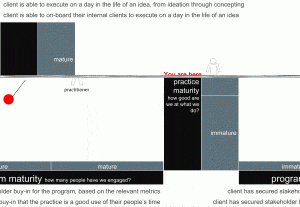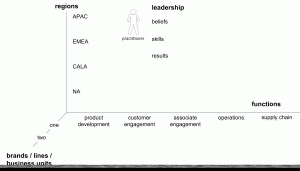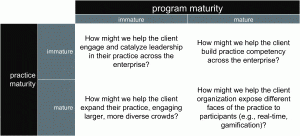Simple Does It
Clients and I talk about innovation management maturity all the time.
How mature is their practice of collaborative innovation? What signs point to maturity? What outcomes speak to maturity? How might they perfect their practice?
I craft a simple visual to help us have the maturity conversation. Figure 1 shows the basic approach.
Figure 1: talking about innovation maturity

Program and Practice Maturity
We resolve maturity across two vectors: program maturity and process maturity.
Program maturity is a function of advocacy and buy-in borne out of confidence in results achieved. How many people are effectively engaged in the practice? How many have seen results?
Practice maturity is a function of operational excellence, sustained over time. How well is the practice understood? How well is the practice executed? How focused are the practitioners on sharing their trade craft with the tyros?
The two maturity vectors reinforce one another. You cannot get too far with one without the support of the other. A mature practice with an immature program means not enough people benefit. The transformation is incomplete. A mature program with an immature practice means you have gained people’s interest, but have failed to satisfy their desire for mastery.
We then through dialogue and by scribbling notes on paper pursue the questions that matter for that stage in the client’s journey. Figure 2 shows examples.
Figure 2: critical questions on innovation maturity


Local and Global Maturity
Lastly, our dialogue moves naturally to the specifics of localized versus global maturity (figure 3). For example, is the supply chain more adept at the practice of collaborative innovation than the brand that serves the Latin American consumer? If so, why?
Figure 3: local versus global maturity

Over to You, Practitioner
How do you talk about maturity with your fellow practitioners?
How do you measure maturity? How do you advance maturity?
How do you tie goals for your practice to the level of maturity that you seek for it?



0 Comments